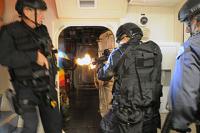-
Studying gun violence is the only way to figure out how to stop it – but we don’t
There are about 32,000 gun deaths a year in the United States. There are another 180,000 or so people injured by firearms annually in the country. These numbers far outstrip the consequences of firearms among our peer high-income countries, with stricter gun regulations. One factor that has inhibited the discussions in the public space over gun violence is the relatively limited data we have available about firearms and firearm violence. Gun violence is a public health problem, but it is not studied the same way other public health problems are. The reason: In 1996 the NRA pushed Congress to prohibit the use of funds made available for injury prevention and control at the Centers for Disease Control and Prevention to be used to advocate or promote gun control. The CDC broadly interpreted this as a bar on firearms research, with other federal funders following suit. This has had a chilling effect on gun research. Because of the bar on research, our understanding of the real consequences of the firearm epidemic is surface deep. The United States has had enormous success in responding to other challenges to public health, including, for example, motor vehicle safety, through gathering data that understands the challenge and implementing structural changes to mitigate the potential harm. On the issue of firearm violence, we are not even at the first step.
-
-
FDA clears military traumatic wound dressing for use in civilian population
Early control of severe bleeding may prevent shock and may be life-saving., as 30 to 40 percent of civilian deaths by traumatic injury are the result of hemorrhaging. Of those deaths, 33 to 56 percent occur before the patient reaches a hospital. Last week the FDA cleared the use of the XSTAT 30 wound dressing, an expandable, multi-sponge dressing used to control severe, life-threatening bleeding from wounds in areas that a tourniquet cannot be placed (such as the groin or armpit) in battlefield and civilian trauma settings.
-
-
FBI unable to break 109 encrypted messages Texas terror attack suspect sent ahead of attack

FBI director James Comey told lawmakers this week that one of the suspects in the foiled terror attack in Garland, Texas, in May had exchanged 109 messages with sources in a “terrorist location” overseas ahead of the attack. U.S. intelligence and law enforcement agencies, however, have not been able to break into and read those messages because they were exchanged on devices equipped with end-to-end encryption software which, security services in the United States and Europe argue, make it impossible to monitor and track terrorists and criminals.
-
-
Assad’s future; Israel’s missile defense; U.S. overseas bases

Israel’s chief-of staff said that the likelihood of the Assad-Hezbollah-Iran axis winning the war in Syria is “zero” (his words). The Alawite community is too small to continue and provide soldiers to Syria’s army; both Iran and Hezbollah appear to have concluded that the cost of maintaining Assad in power is just too high; and Russia has decided against sending ground troops. Israel has successfully tested the Arrow-3, its anti-ballistic system designed to intercept long-range missiles. The Pentagon proposes creating an architecture of hub-and-spokes military bases overseas to fight terrorists.
-
-
WH finalizing executive order tightening background checks of gun buyers

Sources say that the White House is about to announce a new executive order to expand background checks of individuals wishing to purchase guns. One proposal being considered would designate more sellers as high-volume dealers, closing a legal loophole which allows many sales conducted online or at gun shows to escape existing background check provisions. Two other developments on the gun front: On Thursday, Connecticut governor Dan Malloy said he would sign an executive order which would bar people on the government’s terrorism watch lists from buying guns in Connecticut; in the House, Democrats demand that a 17-year ban on government-funded research into violence involving firearms be ended.
-
-
New lie-detecting software uses real court case data
By studying videos from high-stakes court cases, University of Michigan researchers are building unique lie-detecting software based on real-world data. Their prototype considers both the speaker’s words and gestures, and unlike a polygraph, it does not need to touch the subject in order to work. In experiments, it was up to 75 percent accurate in identifying who was being deceptive (as defined by trial outcomes), compared with humans’ scores of just more than 50 percent.
-
-
Human skin detection technology improves security, search and rescue
Color-image based systems are excellent at locating people in aerial search and rescue operations, but fall short when it comes to discerning between actual human skin and objects with similar hues. To remedy this, researchers have developed a novel two-dimensional feature space which uses the spectral absorption characteristics of melanin, hemoglobin and water to better characterize human skin.
-
-
U.K. arrests record number of terrorism suspects, especially women, teenagers

According to the U.K. Home Office quarterly bulletin, 315 terror suspects – a record — have been arrested in the United Kingdom in the past year, with a sharp increases in arrests of women and teenagers. Therise in the number of terrorism-related suspects arrested is a reflection of the determined effort by the police and security services to address the ISIS threat and stem the flow of Britons to, and from, Syria.
-
-
Matching bullets to wounds using organ-specific protein signatures found on projectiles
Forensic medicine has long employed molecular biology to link, for instance, tiny amounts of organic material to a suspect. Yet, such methods are less useful when it comes to finding out which shot or stab wound was the cause of death. They enable a weapon to be linked to the victim, but not the projectile to the wound. Researchers have developed a method which enables them more accurately to reconstruct crimes involving sharp blades or firearms.
-
-
Fibers from natural fats make bulletproof vests stronger and greener
Bulletproof vests and other super-strong materials could soon become even tougher and more environmentally friendly at the same time with the help of extra firm, or “al dente,” fibers. These materials, which are powerful enough to stop speeding bullets, can also be used for many other tasks that require strength.
-
-
Civil liberties coalition condemns cybersecurity bill

Civil libertarians in the United States have a new ally in the fight against the new surveillance bill now being considered in Congress: librarians. The critics of the bill call it both “unhelpful” and “dangerous to Americans’ civil liberties.” House speaker Paul Ryan (R-Wisconsin) has been actively pushing for reconciliation of two bills, the Protecting Cyber Networks Act (PCNA) and the National Cybersecurity Protection Advancement with the Cybersecurity Information Sharing Act of 2015 (CISA), which passed a Senate vote in October.
-
-
Paris attacks expose weaknesses in Europe’s security structure

The 13 November attacks in Paris offered a painful demonstration of Europe’s security loopholes which the terrorists exploited to their advantage. The attacks should serve as a wake-up call to Europeans that the continental security structure, built in another era, is no longer sufficient and needs to be adapted to new circumstances. Whether or not such adaptations can be made, and made in time before the terrorists decide to launch another attack, is an open question.
-
-
Improving police responses to mass shootings

Before Columbine, law enforcement acted on the assumption that mass casualty incidents would involve a barricaded lone shooter who could be isolated, or a hostage situation in which the attackers would engage in negotiation before they killed more people. Thus, protocols established after the 1966 sniper attack at the University of Texas, called for first responders in the United States to set up a perimeter around the site of the shooting, gather as much information as possible, and then wait for specially trained assault teams, hostage negotiators, medics, and other specialists to arrive. “The assumption,” one expert said, “was that time was on their side.” Police forces arriving on the scene of a shooting no longer entertain this assumption.
-
-
It’s time to repeal the gun industry’s exceptional legal immunity

Coming up with effective and realistic solutions to curb gun violence is not easy. Guns pose a tricky dilemma, because they can be used to do good or bad things. They can be used to commit heinous crimes, but they can be used to protect lives as well. The challenge for lawmakers is to come up with ways to reduce the risk of criminal misuse of guns while preserving and even promoting the likelihood of guns being used in beneficial ways. Ensuring that every firearm manufacturer and dealer operates as safely and responsibly as possible should be one piece of the puzzle. A key way to ensure that gun companies have the right incentives would be to repeal the Protection of Lawful Commerce in Arms Act. Enacted in 2005, this federal law gave gun sellers a special immunity from legal responsibilities, which is not enjoyed by any other industry. Gun manufacturers and dealers should not be subject to any extraordinary forms of liability that do not apply to other products. They should not be liable, for example, merely because a firearm is a weapon that is capable of being used to do harm. But if a gun manufacturer or dealer fails to take basic, reasonable precautions in distributing products, it should be held accountable under the law just as an irresponsible company in any other business would be. With the risks of firearms in the wrong hands becoming ever more apparent, Congress should reconsider its regrettable decision to give the gun industry special immunity from legal responsibility.
-
-
Unmanned Maritime Systems 2015 conference: “Reliability, Economy, Endurance”

The theme of the Unmanned Maritime Systems 2015 conference, being held 7-9 December 2015 in Arlington, Virginia, is “Reliability, Economy, Endurance: Requirements for Next-Generation Unmanned Surface and Undersea Systems.” The organizers note that there is a growing demand for Unmanned Maritime Systems (UMS) as today’s geopolitical environment poses a number of unique security challenges in the maritime domain. Advances in power, robotics, computing, sensors, and navigation technologies drive a growing DoD demand for unmanned systems that can provide increased autonomy, persistent resilience, and functionality with decreased risk and expense, showing their value across multiple applications, including otherwise dull, dirty, or dangerous missions.
-
More headlines
The long view
Tantalizing Method to Study Cyberdeterrence
Tantalus is unlike most war games because it is experimental instead of experiential — the immersive game differs by overlapping scientific rigor and quantitative assessment methods with the experimental sciences, and experimental war gaming provides insightful data for real-world cyberattacks.
Using Drone Swarms to Fight Forest Fires
Forest fires are becoming increasingly catastrophic across the world, accelerated by climate change. Researchers are using multiple swarms of drones to tackle natural disasters like forest fires.
Testing Cutting-Edge Counter-Drone Technology
Drones have many positive applications, bad actors can use them for nefarious purposes. Two recent field demonstrations brought government, academia, and industry together to evaluate innovative counter-unmanned aircraft systems.
European Arms Imports Nearly Double, U.S. and French Exports Rise, and Russian Exports Fall Sharply
States in Europe almost doubled their imports of major arms (+94 per cent) between 2014–18 and 2019–23. The United States increased its arms exports by 17 per cent between 2014–18 and 2019–23, while Russia’s arms exports halved. Russia was for the first time the third largest arms exporter, falling just behind France.
How Climate Change Will Affect Conflict and U.S. Military Operations
“People talk about climate change as a threat multiplier,” said Karen Sudkamp, an associate director of the Infrastructure, Immigration, and Security Operations Program within the RAND Homeland Security Research Division. “But at what point do we need to start talking about the threat multiplier actually becoming a significant threat all its own?”
The Tech Apocalypse Panic is Driven by AI Boosters, Military Tacticians, and Movies
From popular films like a War Games or The Terminator to a U.S. State Department-commissioned report on the security risk of weaponized AI, there has been a tremendous amount of hand wringing and nervousness about how so-called artificial intelligence might end up destroying the world. There is one easy way to avoid a lot of this and prevent a self-inflicted doomsday: don’t give computers the capability to launch devastating weapons.
